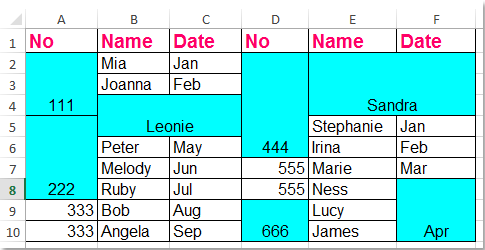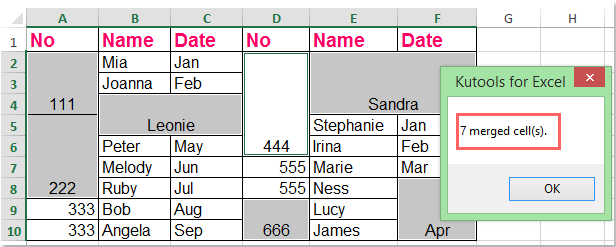如何在 Excel 中識別並選取所有合併的儲存格?
你知道如何在 Excel 中尋找並選取所有合併的儲存格嗎?以下是三種快速識別並選取 Excel 中某個選定範圍或區域內所有合併儲存格的巧妙方法。

使用「尋找」命令識別並選取所有合併的儲存格
你可以透過以下步驟,使用「尋找」命令來識別並選取當前工作表中的所有合併儲存格:
1. 點擊「Home(主頁)」>「Find & Select(尋找與選取)」>「Find(尋找)」以打開「尋找和替換」對話框。你也可以通過按下 Ctrl + F 鍵來打開「尋找和替換」對話框。
2. 在對話框中點擊「Format(格式)」按鈕。(如果找不到「Format(格式)」按鈕,請點擊「Options(選項)」按鈕以展開對話框。)請參閱截圖:

3. 在彈出的「尋找格式」對話框中,僅勾選「Alignment(對齊)」標籤下「Text control(文字控制)」部分中的「Merge Cells(合併儲存格)」選項,然後點擊「OK(確定)」。

4. 現在回到「 尋找和替換」對話框,點擊「尋找全部」按鈕。所有合併的儲存格都會列在該對話框的底部。按住 Shift 鍵選取所有尋找結果。
當你選取所有尋找結果時,當前工作表中的所有合併儲存格都已被選取。請參閱截圖:

提示:如果你只想識別、尋找並選取某個選定範圍內的合併儲存格,你需要先選擇該範圍。
使用 Kutools for Excel 選取並計算所有合併的儲存格
Kutools for Excel 的「選擇合併儲存格」工具將幫助你只需單擊一下即可識別、尋找並選取某個選定範圍內的所有合併儲存格。
安裝 Kutools for Excel 後,請按照以下步驟操作:( 立即免費下載 Kutools for Excel! )
1. 選擇你想選取合併儲存格的資料範圍。
2. 點擊「Kutools」>「Select(選擇)」>「Select Merged Cells(選擇合併儲存格)」,請參閱截圖:

3. 選定範圍內的所有合併儲存格會立即被選取,並且也會計算合併儲存格的數量。請參閱截圖:
使用 VBA 程式碼識別所有合併的儲存格
VBA 1:識別並高亮顯示所有合併的儲存格
1. 按住 ALT + F11 鍵,這將打開 Microsoft Visual Basic for Applications 視窗。
2. 點擊「Insert(插入)」>「Module(模組)」,並將以下宏粘貼到模組視窗中。
Sub FindMergedcells()
'updateby Extendoffice
Dim x As Range
For Each x In ActiveSheet.UsedRange
If x.MergeCells Then
x.Interior.ColorIndex = 8
End If
Next
End Sub
3. 按下 F5 鍵運行此宏。當前工作表中的所有合併儲存格都被識別並高亮顯示。請參閱截圖:

VBA 2:識別並列出所有合併的儲存格
1. 按住 ALT + F11 鍵,這將打開 Microsoft Visual Basic for Applications 視窗。
2. 點擊「Insert(插入)」>「Module(模組)」,並將以下宏粘貼到模組視窗中。
Sub ListMergedcells()
'updateby Extendoffice
Dim x As Range
Dim sMsg As String
sMsg = ""
For Each x In ActiveSheet.UsedRange
If x.MergeCells Then
If sMsg = "" Then
sMsg = "Merged cells:" & vbCr
End If
sMsg = sMsg & Replace(x.Address, "$", "") & vbCr
End If
Next
If sMsg = "" Then
sMsg = "No merged cells."
End If
MsgBox sMsg
End Sub
3. 按下 F5 鍵運行此宏,所有合併的儲存格都會在彈出的對話框中列出。請參閱截圖:

相關文章
如何在受保護的工作表中允許合併儲存格?
默認情況下,受保護的工作表不允許用戶合併儲存格。然而,你可以使用我們在本文中提供的 VBA 方法,在受保護的工作表中合併儲存格。
如何在 Excel 中合併已格式化為表格的範圍中的儲存格?
在 Excel 中,你可以輕鬆地使用「合併並居中」功能將一些連續的儲存格合併成一個,如下方截圖所示。但是,它無法合併那些在 Excel 中格式化為表格的範圍中的儲存格,有什麼技巧可以解決這個問題嗎?
如何在 Excel 中合併儲存格但不居中內容?
在 Excel 中,當合併兩個或多個儲存格時,「合併並居中」功能可以幫助你。但在某些情況下,如果你只想合併儲存格而不居中內容,該怎麼辦呢?本教程將介紹在 Excel 中解決這個問題的方法。
如何取消合併儲存格並填充重複值?
如果你有一個包含大量合併儲存格的工作表,現在你需要取消合併它們,並自動向下填充來自合併儲存格的原始值,如下方截圖所示。你該如何快速處理這個任務?
最佳 Office 生產力工具
| 🤖 | Kutools AI 助手:以智能執行為基礎,革新數據分析 |生成程式碼 | 創建自訂公式 | 分析數據並生成圖表 | 調用 Kutools 增強函數… |
| 熱門功能:查找、選取項目的背景色或標記重複值 | 刪除空行 | 合併列或單元格且不遺失數據 | 四捨五入(免公式)... | |
| 高級 LOOKUP:多條件 VLookup|多值 VLookup|多表查找|模糊查找... | |
| 高級下拉列表:快速創建下拉列表 |依賴型下拉列表 | 多選下拉列表... | |
| 列管理器:添加指定數量的列 | 移動列 | 切換隱藏列的顯示狀態 | 比較區域及列... | |
| 精選功能:網格聚焦 | 設計檢視 | 增強編輯欄 | 工作簿及工作表管理器 | 資源庫(快捷文本) | 日期提取器 | 合併資料 | 加密/解密儲存格 | 按列表發送電子郵件 | 超級篩選 | 特殊篩選(篩選粗體/傾斜/刪除線...)... | |
| 15 大工具集:12 項文本工具(添加文本、刪除特定字符…)|50+ 儀表 類型(甘特圖等)|40+ 實用 公式(基於生日計算年齡等)|19 項插入工具(插入QR码、根據路徑插入圖片等)|12 項轉換工具(金額轉大寫、匯率轉換等)|7 項合併與分割工具(高級合併行、分割儲存格等)|...及更多 |
運用 Kutools for Excel,全面提升您的 Excel 技能,體驗前所未有的高效。 Kutools for Excel 提供超過300 項進階功能,讓您提升工作效率、節省時間。 點此尋找您最需要的功能...
Office Tab 為 Office 帶來分頁介面,讓您的工作更加輕鬆簡單
- 在 Word、Excel、PowerPoint 中啟用分頁編輯與閱讀。
- 在同一視窗的新分頁中打開與創建多份文件,而非開啟新視窗。
- 提升您的生產力50%,每日可幫您減少數百次鼠標點擊!
所有 Kutools 外掛,一次安裝
Kutools for Office 套裝整合了 Excel、Word、Outlook 和 PowerPoint 的外掛,外加 Office Tab Pro,非常適合需要跨 Office 應用程式協同作業的團隊。
- 全合一套裝 — Excel、Word、Outlook及 PowerPoint 外掛 + Office Tab Pro
- 一鍵安裝,一份授權 — 幾分鐘完成設置(支援 MSI)
- 協同運作更順暢 — Office 應用間無縫提升生產力
- 30 天全功能試用 — 無需註冊、無需信用卡
- 最超值 — 一次購買,節省單獨外掛費用
